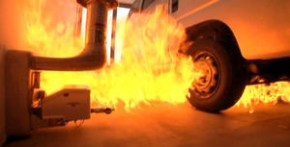 The excellent documentary film “Incendiary” (read more about the film here) reminded me of an arson case in Japan, the so-called Higashi-Sumiyoshi Case. Its retrial petition is currently being reviewed by Osaka High Court.
The excellent documentary film “Incendiary” (read more about the film here) reminded me of an arson case in Japan, the so-called Higashi-Sumiyoshi Case. Its retrial petition is currently being reviewed by Osaka High Court.
In the late afternoon of July 22, 1995, an 11 year old girl was killed in her own house in Higashi-Sumiyoshi Ward, Osaka, when a fire broke out. She was taking a shower and could not escape from the fire. The house was built mainly with wood and the fire was said to have broken out from the car parked on the first floor in the garage of the house. Her mother (Keiko Aoki), Aoki’s common-law husband (Tatsuhiro Boku) and Aoki’s son were able to escape from the fire.
The initial investigation by the fire department concluded that the cause of the fire was unknown. However, since (1) Aoki and Boku had life insurance coverage on the girl, and (2) the house was locked from the inside, the police suspected that it was an arson case. Their theory was that Aoki and Boku conspired together to get the insurance money by killing the girl. Thus, they tried to get the evidence by interrogating the couple.
The police arrested Aoki and Boku on September 10, 1995, after “voluntarily” taking them to the police station and obtaining their confession after a “voluntary” interrogation which took place from the morning. Aoki recanted her confession before the indictment and has maintained to claim her innocence ever since, even though the interrogation continued almost daily for a month after her recantation. Boku also recanted his confession after he was indicted.
Although the prosecution had no physical evidence, they indicted Aoki and Boku separately for murder, arson and attempted insurance fraud on September 30, 1995. The main evidence in both trials was confession, obtained during investigation. The prosecutors stated in the indictment that Boku was the principal of the crime, causing fire by spreading 7.3 liters of gasoline on the floor and lighting it with a lighter.
The trial court (Osaka District Court) relied on Aoki and Boku’s confession and they were both sentenced to life imprisonment in 1999.
There was actually an experiment by the prosecution before indictment, reenacting the fire according to Boku’s confession. They reproduced the crime scene (they built the house with the garage), prepared a vehicle, spread 6 liters of gasoline on the ground of the garage and set the whole thing on fire with a lighter. The result of the experiment was presented as evidence at trial.
It was clear that the result of the experiment was inconsistent with Boku’s confession and other witnesses’ statements in many ways. For example, the house was ablaze in 5 seconds in the experiment (even though the gasoline used in the experiment was considerably less than the amount that was used in the alleged crime according to Boku’s confession) and there were blasts of fire for 40 seconds thereafter, producing a huge amount of black smoke. There would have been no time for Boku to go back inside the house, lock the door and get out, as he stated in his confession.
The defense tried to persuade the court by arguing these inconsistencies. However, the trial court stated in the judgment that there was no huge contradiction or difference between the actual fire and the experiment, and the defendants’ confessions were reliable. The court also rejected the statement of an expert witness for the defense which would have proved that the fire could have occurred by vaporization of the gasoline from the car.
Aoki and Boku appealed the decision, but the Osaka High Court (2004) and the Supreme Court (2006) rejected their appeals.
Continued to Part 2…


















Pingback: A Dubious Arson Case – Higashi-Sumiyoshi Case (Part 2 of 2) | Wrongful Convictions Blog
Pingback: Role of Prosecutors in Postconviction Proceedings | Wrongful Convictions Blog
Pingback: False Confessions as Major Cause of Wrongful Convictions in Japan | Wrongful Convictions Blog
Pingback: Supreme Court Denies Release in Higashi-Sumiyoshi Case | Wrongful Convictions Blog
Pingback: Breaking News: Osaka High Court Rejects Appeal by Prosecutor, Orders Release in Higashi-Sumiyoshi Arson Case | Wrongful Convictions Blog
Pingback: Retrial of the Higashi-Sumiyoshi Arson Case | Wrongful Convictions Blog